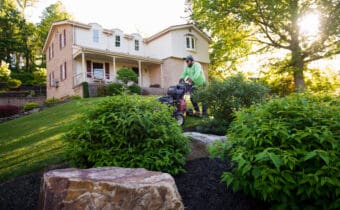Soil health is one of the little understood aspects of residential landscapes for a very simple reason. Everything is happening quietly beneath the surface.
In fact, just as plant professionals go to the soil to get to the root of plant problems, you may wish to check in periodically too.
Just like a physician, a plant horticulturist will not make a diagnosis just from what they see on the surface. He or she will literally go deeper to discover more about air, water, food, and shelter – the essential needs of every living creature.
Understanding the basics of lawn and landscape soils will equip you to make informed choices for the trees and shrubs at your home.
How Lawn and Landscaping Soils Do Their Job
 Soils are part of a larger ecosystem that provide plants with everything they need to thrive in conditions ranging from sweltering, wind-blown summers to sub-zero winters that we get in Pittsburgh.
Soils are part of a larger ecosystem that provide plants with everything they need to thrive in conditions ranging from sweltering, wind-blown summers to sub-zero winters that we get in Pittsburgh.
This includes getting air and water to plants while also providing the right environment for beneficial micro and macro organisms to flourish, such as earthworms and microbes.
That’s right – your soil is alive. In fact, studies show some of those microbes are active and doing their work even when the ground is completely frozen.
#1. Air and Moisture
Plants are living creatures that share many similarities with human beings. They can survive extended periods without food, but cannot go very long without air or water – and the two have to work together.
Let’s say the leaves of your tree are falling off. One of the first things you should do is examine the soil. If it’s dry you know that your tree needs water. If it is saturated with water that’s an indication much of the air has been squeezed out and your tree is suffocating.
If it’s not too late, the solution is to pull back the surface layer of mulch so that it can dry out and allow more air to enter.
#2. Soil Structure
You live in a house with rooms that store items you use, provide space for future needs, and allow circulation for day-to-day activities.
Soil structure works the same way. The best structure is sufficiently loose enough to create “rooms” that hold air and water, provide space for microbes to break down organic matter for plants, and allow for the root system to grow.
This is the purpose behind aerating your lawn or cultivating planting beds to loosen compaction and improve soil structure. The next step is to ensure there is plenty of organic matter available.
#3. Organic Matter
In addition to the natural structure of soil, which could be sandy, gravelly, or clayey, there is the structure that organic matter gives it.

Leaves and twigs make spaces that hold air and water so that it’s available for plants.
By now you are getting the idea that the secret to getting and keeping your lawn and landscaping healthy is when everything is balanced. That’s the definition of an ecosystem, one that is partly above the surface and partly underground.
Dream Greener Soil Enhancement Practices
There are a number of practices that we recommend for keeping your soils healthy. Some that have been mentioned here are proper watering and cultivation that you can do yourself.
Here are a few others to consider that are dependent on the current state of your soil profiles.
Mulching and Soil Amending
Most of our clients mulch their landscapes at least once every year, typically in the spring. Along with redefining crisp bed edges, this practice gives landscaping beds that like-new appearance that everybody loves.
In addition to the cosmetic benefits, mulching is invaluable for minimizing temperature and moisture fluctuations that can play havoc on the health of your plants. And it minimizes weeds and adds organic matter as it is naturally broken down.
Soil and Organic Matter Replacement
Sometimes it’s necessary to go a step further to remove spent soils that are depleted of organic matter and whose structure is broken beyond repair. This is especially true of clay-type soils have been overly compacted.
 In situations like this it’s necessary to remove the existing soil in planting beds and replace it with fresh soil that has the right structure and abundant organic matter. Our clients that have done this tell us their seasonal flowers displays are now among the brightest in the neighborhood.
In situations like this it’s necessary to remove the existing soil in planting beds and replace it with fresh soil that has the right structure and abundant organic matter. Our clients that have done this tell us their seasonal flowers displays are now among the brightest in the neighborhood.
This may also be necessary for getting turfgrass to grow in heavily trafficked areas or where deicing salt has effectively killed what is good about the soil. We remove the old sod and 2-4 inches of the current soil and replace it with fresh soil and new sod.
If you have read this far you not only know more about soils than 90% of your neighbors, but also how important they are to enjoying a vibrant lawn and landscape!
Now it’s time to take action. Give us a call today at 412-835-1035 and we will help you make an accurate soil assessment and work with you to make plans for getting your lawn and landscape in top shape!



